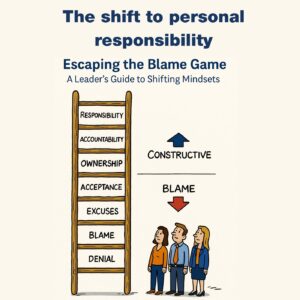Henry David Thoreau once said, “It’s not what you look at that matters, it’s what you see.”
Shakespeare echoed the same idea: “The eyes see all, but the mind shows us what we want to see.”
Both quotes point to a powerful truth: your perspective shapes your reality.
In leadership, that truth matters more than ever. The way you interpret a situation influences:
how you respond,
the decisions you make,
the behaviours you adopt, and
the results you ultimately achieve.
That’s why maintaining perspective is one of the most important—yet most overlooked leadership skills in Australia today.
Why Perspective Matters
Imagine someone starting their first job. They’re told:
“If you work hard and put in the extra effort, you’ll be rewarded—promotions, pay rises, bonuses, the lot.”
That perspective shapes their ambition, effort, and behaviour.
Then they go for a promotion… and don’t get it.
Now what?
Do they think:
“I should work even harder”?
Or:
“Why bother?”
If they choose “why bother”, their performance will dip, their mindset will narrow, and they’ll likely miss the next opportunity. Even if they move to another company, the same thinking will follow them—and the same outcomes will repeat.
This is a classic example of cognitive bias in leadership.
Our interpretation, not the event, determines our trajectory.
That’s why leaders must know how to change your perspective, especially when under pressure.
Perspective, Bias and Leadership Behaviour
Your perspective influences:
how to stay positive at work,
emotional reactions,
decision making under pressure,
how you interpret team behaviour, and
the culture you create.
Ignore perspective, and you ignore one of the strongest forces shaping your leadership mindset.
The good news?
Perspective can be changed.
In fact, learning to shift perspective is a core part of:
resilience training in Australia,
leadership development Australia, and
programs that build professional resilience and workplace wellbeing.
Perspective → Drives decisions
Decisions → Drive behaviour
Behaviour → Drives culture and performance
This is why leaders with strong emotional intelligence consistently achieve better outcomes.
How to Keep a Healthy Perspective
Here’s a practical activity you can test right now:
Extend both arms straight out in front of you.
Slowly move them outward until they leave your peripheral vision.
You’ll notice your field of vision is much wider than you usually acknowledge—almost 180 degrees.
A perfect metaphor for leadership.
Your system is designed for a wide perspective, deep awareness, and mental clarity and focus.
But under stress, busyness, or pressure, leaders narrow their focus. They miss important information, overlook opportunities, and fall into reactive thinking.
That’s when mistakes happen.
If you want a powerful example, search “Selective Attention Test” on YouTube.
It’s a scary demonstration of how easily we miss what’s right in front of us.
Why Leaders Lose Perspective
Your brain uses a filtering system called the Reticular Activating System (RAS).
It screens the constant flow of information and prioritises what you tell it is important.
Think about buying a new car suddenly you see that car everywhere.
That’s your RAS in action.
But this filtering can distort your leadership viewpoint:
If you believe a team member is struggling, your RAS will notice their mistakes.
If you believe they’re talented, your RAS will amplify their strengths.
If you feel overwhelmed, your RAS will highlight threats instead of solutions.
This is why mindfulness at work is so important in modern leadership—it helps you reset your filter and regain perspective.
How Great Leaders Maintain Perspective
Great leaders know their perception is rarely the full story.
They challenge it by intentionally balancing the lens they look through.
Try these simple leadership habits:
1. Look for disconfirming evidence
If you think someone is “underperforming”, deliberately look for everything they’re doing well.
2. Shift from judgement to curiosity
Replace
“They’re wrong.”
with
“I wonder what I’m not seeing?”
3. Step back before stepping in
Professional resilience begins with pausing to regain mental clarity—not reacting in the moment.
4. Keep a growth mindset in the workplace
Adopt the belief that skills, performance, and perspective can change.
5. Protect your workplace wellbeing
Fatigue, stress, and overwhelm narrow perspective more than anything else.
These are core elements in our Resilience and Leadership Workshops, where leaders learn the emotional intelligence, perspective management, and decision-making tools essential for today’s fast-paced environments.
Healthy Perspective → Better Decisions → Better Leadership
When leaders manage their perspective intentionally, they make better choices—even under pressure.
They communicate more clearly.
They respond more constructively.
They engage people more effectively.
They adapt faster.
They build stronger teams.
Perspective doesn’t just change what you see.
It changes how you lead.
If your leaders struggle with maintaining perspective, we can help.
Our resilience and leadership programs are designed to improve:
perspective management
emotional intelligence
decision making under pressure
resilience and mindset
workplace wellbeing
leadership identity and capability
Reach out any time for an obligation-free conversation.
📞 Call Team Focus Plus on 1300 551 274 or
📧 Email team@teamfocusplus.com
to discuss how our leadership programs in Australia can help your business grow from good to exceptional.
Or call me directly: Ross Judd – 0412 490 250
Stay Connected
Sign up for our newsletter to get updates on upcoming workshops and transformational leadership programs.






